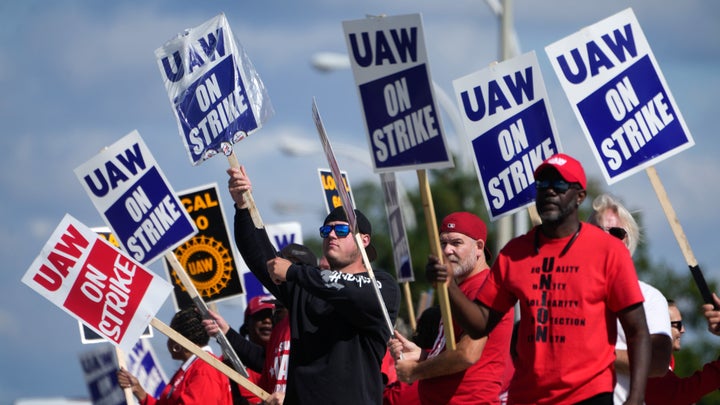When the United Auto Workers successfully concluded their strike against the “Big Three” auto manufacturers last fall, the union’s president, Shawn Fain, invited other unions to lay the groundwork for an even more powerful strike on May 1, 2028. Now local labor activists are answering Fain’s call.
They’re doing so by encouraging unionized workers to move the expiration dates for their contracts to April 30, 2028, just before International Workers’ Day, or May Day, as it’s commonly known. By aligning their contracts to end at the same time, unions could threaten to strike simultaneously, perhaps across industries, giving them greater economic and political leverage as they bargain with employers.
As Fain put it, “It’s important that we not only strike, but that we strike together.”
To that end, several local labor councils around the country have recently passed resolutions endorsing Fain’s proposal, recommending their affiliates try to shift the dates on which their contracts come up. Collective bargaining agreements typically include a no-strike clause that forbids work stoppages while the contract is in effect, making the expiration date the most likely time for a walkout.
“I think it’s really a bold call for organized labor to set our aims higher than managing decline.”
– Connor Lewis, president, Seven Mountains Central Labor Council
Eight councils affiliated with the AFL-CIO labor federation have endorsed the concept so far, said Connor Lewis, a union member, writer and president of the Seven Mountains Central Labor Council in central Pennsylvania. The councils span six states; the most recent to sign on was the council for Louisville, Kentucky, where Ford workers went on strike last year.
“Unions have really been handcuffed in what we can do to effectively organize to get significant gains for working people, whether they’re union members or not,” Lewis told HuffPost. “I think it’s really a bold call for organized labor to set our aims higher than managing decline and to actually, like so many unions are doing now, fight for raising standards.”
A website Lewis and others built called “Bargain Together” calls on workers to “prepare for mass strikes” on May 1, 2028.
“UAW issued the call. We’re answering,” it proclaims.
The maneuver’s backers see it as one way to work around U.S. legal restrictions on striking.
The Taft-Hartley Act of 1947 weakened organized labor in part by banning “secondary” or “sympathy” strikes, in which workers would strike one employer in order to pressure another, such as a business partner or supplier. Congress passed the law following a historic wave of disruptive work stoppages in 1945 and 1946 that involved millions of workers in the auto, energy, food, film and other industries.

Large-scale, simultaneous strikes tied to contract expirations could achieve by legal means the sort of cross-industry troublemaking that was outlawed decades ago. They could also maximize unions’ clout at a time when just one in ten U.S. workers belongs to a union, down from roughly one in three at organized labor’s peak in the 1950’s.
“This is a really innovative way to work within the law to actually achieve the kinds of gains and fight the kinds of fights we haven’t really seen since the days of the CIO,” Lewis said, referring to the Congress of Industrial Organizations, which organized industrial workers en masse in the 1930’s and 40’s, before merging with the American Federation of Labor.
Collective bargaining agreements typically last a certain number of years; many last about three to five. Shifting the calendar date on which contracts typically end requires the employer’s cooperation in bargaining. Some companies may be resistant to either shortening or lengthening their contracts to coincide with a potential general strike — especially if the idea is to give unions more leverage in the future.
Jake Morrison, a union member and president of the North Alabama Area Labor Council, said aligning contracts to end on May Day will require buy-in from rank-and-file union members. After all, it is a demand like any other, like higher wages, more vacation time or increased retirement contributions.
Morrison’s council was the first to pass a resolution endorsing Fain’s idea, doing so unanimously. He said one union in his area is already working on moving its contract’s expiration date.
“It does seem like in North Alabama people are excited to try to prioritize it and be a part of something bigger,” said Morrison, who hosts an Alabama radio show called “The Valley Labor Report.”
Morrison said the strike against Ford, General Motors and Jeep parent company Stellantis was a strong example of how aligned contracts can give unions more power.
“People are excited to try to prioritize it and be a part of something bigger.”
– Jake Morrison, president, North Alabama Area Labor Council
By walking out at the Big Three simultaneously — something the UAW had never done before in its history — union negotiators were able to play the automakers off one another during bargaining, pressuring them to match each other’s offers. The UAW also struck only certain facilities as a matter of strategy, leaving room for escalation and keeping its game plan unpredictable.
“It was an illustration of what coordinated bargaining can do,” Morrison said. “You can see this even in industries where union density is high but they don’t have contracts aligned – it makes it really easy [for employers] to whipsaw one local or one department or one region against another.”
The UAW lengthened its four-year contracts at Ford, GM and Stellantis by several months in order to move their expirations to April 30. The switch, Fain said, was partly in recognition of May Day, an international holiday with radical roots in the United States.
Workers seeking an 8-hour workday waged mass strikes on May 1, 1886, leading to a police crackdown. Three days later, someone tossed a bomb into a crowd at Chicago’s Haymarket Square, setting off a deadly riot. Eight labor activists were later convicted in what was denounced as a sham trial.
Fain said that the fight for a standard workday is a struggle “just as relevant today as it was in 1889,” the year a federation of unions designated May Day a holiday.
But he also acknowledged there was a logistical reason to push the contract expiration back at the Big Three. The union has an ambitious goal — organizing several historically non-union automakers, such as Mercedes, Toyota and Hyundai — and the longer contracts could give them additional time to align new agreements at those companies. Fain said the negotiations in 2028 won’t be with just the Big Three, “but the Big Five or Big Six.”
The union succeeded in the first major test of its organizing plan, winning a historic election at the Volkswagen plant in Tennessee last week by a landslide. The UAW had previously lost two votes at the same facility and struggled for years to gain a toehold at foreign-owned plants in the South.
Morrison said the victory was a sign that unions are ready to break out of a “defensive” posture.
“What you can see from Volkswagen in Chattanooga, it’s inspiring to people to see that we can win and we can win together,” he said. “This is a really important call.”







